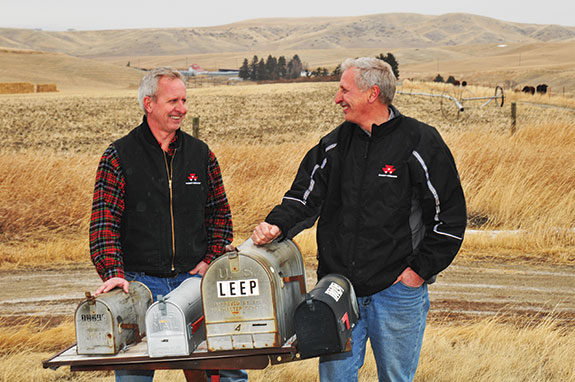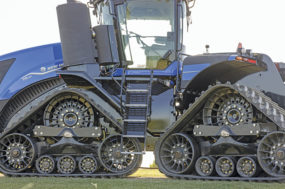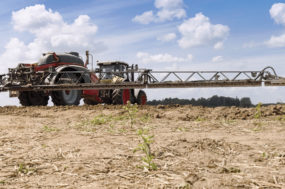Standing on this domed stretch of Leep family land, you can see mountains in every direction – tall peaks, some reaching two miles above sea level.
And on those evenings in winter, when it’s not snowed in and the sun sits low, the sky glows with a deep blue that hints at the vastness of space and things much larger than those of us standing on this hayfield.
The massive ranges, the black soil underfoot, the magnitude of this, the Gallatin Valley, and those heavens above can leave the onlooker breathless and humbled, feeling equal parts in awe and insignificant.
“You know,” says Greg Leep, who with his brother Sherwin runs Leep Hay & Grain, “you can get sucked into your problems and not look around and enjoy the beauty of God’s creation.
My wife always kids me. She says, ‘You need to look up once in a while; look at the mountains and scenery around you here.’
“That’s good advice,” admits Greg, “because I can get focused on dry spots and things like that. If we’ll get enough rain.
Can we get the hay delivered in time? Will it come at the right price? But it is a great place to live and raise a family.”
“It is an extraordinary place to live and work,” adds Sherwin. “It’s been my experience that we begin to notice [these things] more as we get older. We take such beauty for granted at times.”
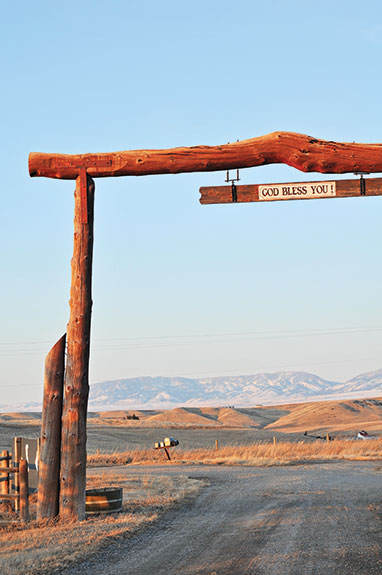 The gateway to the Leep family’s “outdoor office.”
The gateway to the Leep family’s “outdoor office.”
The Leep brothers
The Leep brothers are the third generation of their family to farm this area just south and west of Bozeman, Montana.
As was their grandfather who settled in the valley in 1926, when the area was much wilder and us humans much more vulnerable, they’re part of a Dutch-American enclave that gives this region a subtle, yet distinct flavor.
As are the Leeps, many residents here are members of the Christian Reformed Church, a denomination with roots in Calvinism and the old country.
America – both the U.S. and Canada – offered these new arrivals opportunity that, coupled with their belief in what came to be known as the Protestant work ethic, fueled multiple immigration waves beginning in the 17th century.
“Being people of faith, we certainly give God the credit for opportunities and safety and help and just blessing us in our work,” says Andy Leep, who with sons Greg and Sherwin built the business from scratch to its present expanse of some 5,000 acres, both owned and rented.
“We’re a Christian people. Even though, of course, that is not exclusive to the Dutch by any means, it’s part of our heritage.”
Today, the Leeps – who not-so-incidentally attend church in the nearby town of Amsterdam – remain connected to their Dutch heritage.
It’s a tight community, but the people are as hospitable as they come, perhaps because even today a warm hearth in a place where the climate can get brutal can save the life of a neighbor or stranger.
When Rob Lagerstrom and I went to visit them last winter, they certainly welcomed us and shared not only many hours of their time, but what they believe to be the ingredients in their success.
Remaining humble, even in light of their good fortune, the brothers put a tremendous amount of thought into the discussion – as much as any farmers we’ve interviewed.
What they offered us was a mix of common sense and brilliantly simple approaches to their line of work, all of which are themselves worthy of sharing. So, in turn, we’re now passing those thoughts on to you.
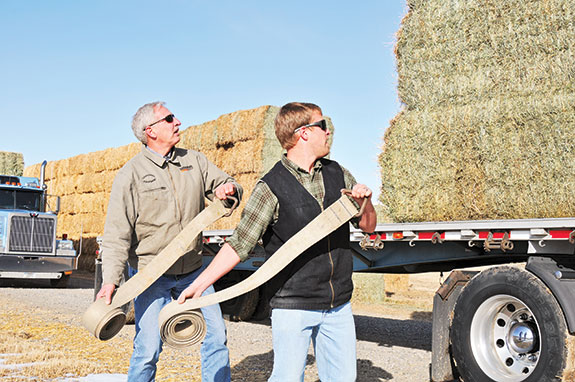 Sherwin and son Brendan prepare a load of hay for transport.
Sherwin and son Brendan prepare a load of hay for transport.
Operational basics
Sherwin states, “We’ve tried to grow in the business and not ‘go into business.’ We tried to do it gradually, one step at a time.And then all winter is basically delivering product, establishing customer relationships and working on farm programs.” He also emphasizes paying their bills on time.
“That’s something we found was really critical, especially in landlord relations, but that goes all the way across the board. We pay our suppliers and landlords, and everything is done as timely as we can.
“Building relationships … has been one of the keys for us. Dad spent many years as a part-time cattle trader, so we were able to establish contacts with folks in the livestock industry.
That gave us a springboard for finding customers for our hay business early on. Also, Greg and I for years did the trucking together, so we had a very firsthand interaction with the end users.
Sometimes that meant going the extra mile, delivering hay in the worst blizzards imaginable.
“When setting up irrigation systems, you can’t be afraid of obstacles, such as hills or ditches, or things like that. We learned from a man we worked for early on … who would rearrange the land or bridge canals.”
Greg adds, “We rotate alfalfa. That rotation gets nitrogen back into the soil, breaks up the disease cycles and things like that.
We’ve typically left alfalfa in four to six years, and then go a couple years of wheat and a couple years of barley.”
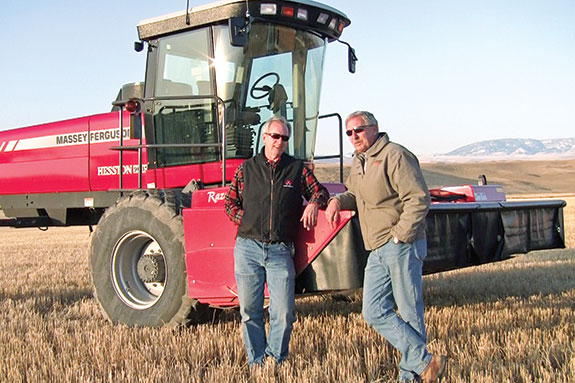 Greg and Sherwin are the third generation of their family to farm this area near Bozeman, Montana.
Greg and Sherwin are the third generation of their family to farm this area near Bozeman, Montana.
Equipment and service
The Leeps run a fleet of Massey Ferguson and Hesston equipment that includes seven tractors, two windrowers and three large square balers.
They feel the equipment is very fuel-efficient and keeps getting better as the company continues to fine-tune the maintenance and user-friendliness.
Sherwin says, “We just can’t afford a lot of downtime. For example, during one harvest, we had a warm, windy day before cold set in, and we had about 250 to 300 acres of third-cutting hay. We had all those machines running all day long, racing.
“Everything worked perfectly, and we’re so grateful because it’s a window of opportunity. It’s there for a day and then it closes.”
They also maintain a good working relationship with their dealership, Churchill Equipment.
“Our salesman has a sense of what will work. He pretty much knows if he’s got a favorable price or if it’s the right type of machine for us.
“We added up all of our repair bills, and it was like $7,100 over five years for seven tractors. That’s just not that much, especially considering how hard we run them.
“They have a good team … the service people, the parts department is refreshingly organized and knowledgeable. They’ve got good people, and that’s worth a lot. It’s been a good relationship.”
The future
“When we look at our operation and how it’s evolved, our focus has been trying to grow the base and the acreage, and we’ve been pretty successful at that, thankfully.[Growth] is not off the radar, but we want to focus more on intensifying things a little bit – maybe sharpening up on varieties and some of the practices, maybe move into more minimum and no-till, and those sort of practices,” says Sherwin.
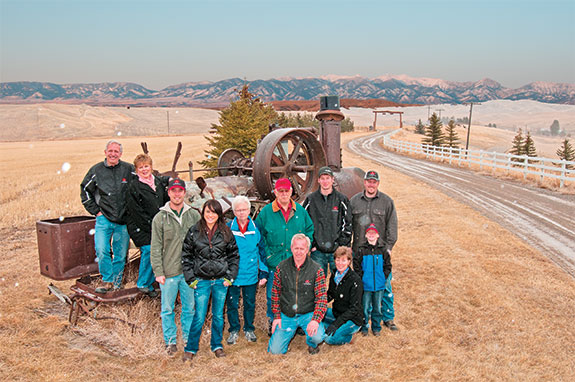 Members of the Leep family with an old steam tractor posted like a sentry at the entrance to the old family home.
Members of the Leep family with an old steam tractor posted like a sentry at the entrance to the old family home.
“We do have an [estate] plan in place that’s intended to preserve the operating entity. We’re committed to keep that up-to-date over the years, at least meeting with our attorney once a year.
"It’s kind of a moving dynamic. Neither of us is planning on retiring in the foreseeable future, but you never know. When you get to the age I am – I’m 57 – you need to start thinking about it.
“Obviously, being in agriculture we have a real affinity for the land and care about what happens to it and want to preserve it.
"There’s a lot of development pressure here, but our county passed an open space bond, which enabled people to enter into permanent conservation easements and get some payment toward the diminished [potential value] that was forfeited.
"So, that was an incentive for us, as well as the federal tax benefit, so we did do that on two of our properties. Preserving the land and having kids interested in agriculture was certainly a factor too.”
—Excerpts from Massey Ferguson FarmLife magazine, Winter 2012
To read this story in full, visit the Massey Ferguson site.
